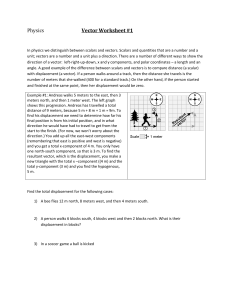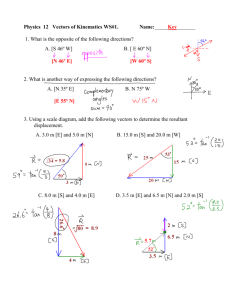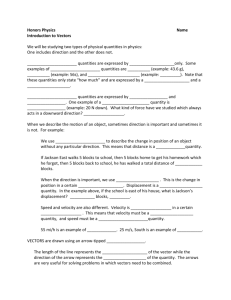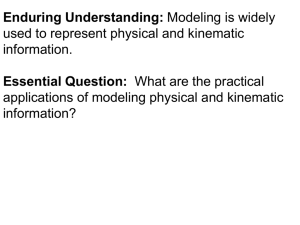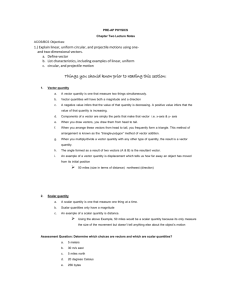Physics Vector Worksheet #1
advertisement
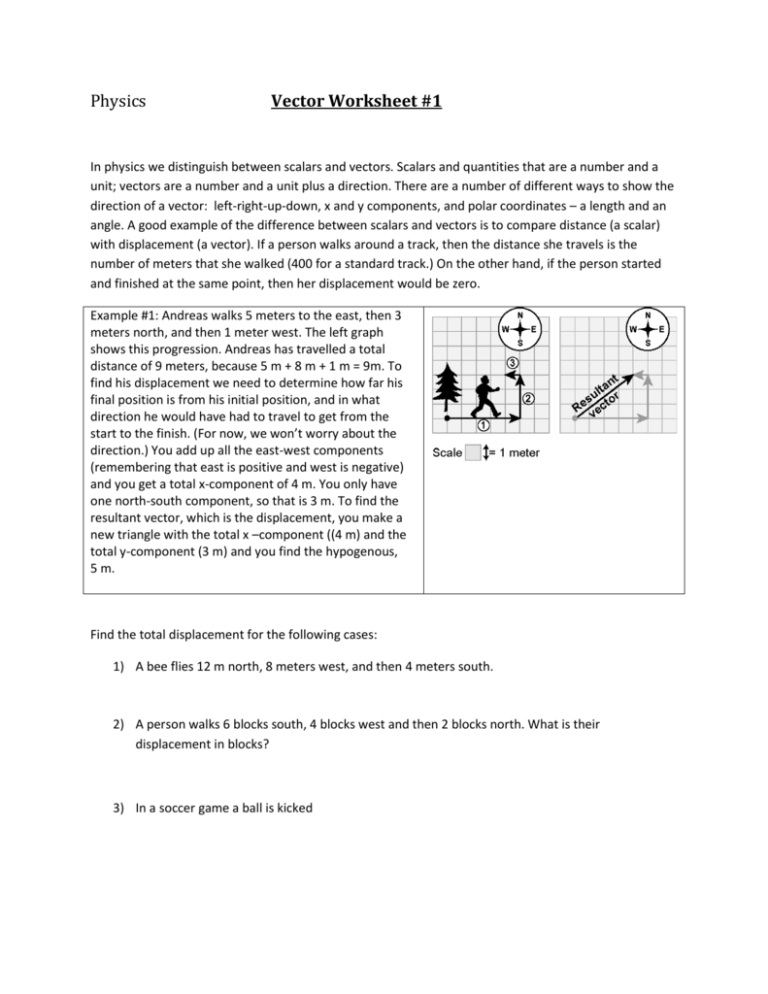
Physics Vector Worksheet #1 In physics we distinguish between scalars and vectors. Scalars and quantities that are a number and a unit; vectors are a number and a unit plus a direction. There are a number of different ways to show the direction of a vector: left-right-up-down, x and y components, and polar coordinates – a length and an angle. A good example of the difference between scalars and vectors is to compare distance (a scalar) with displacement (a vector). If a person walks around a track, then the distance she travels is the number of meters that she walked (400 for a standard track.) On the other hand, if the person started and finished at the same point, then her displacement would be zero. Example #1: Andreas walks 5 meters to the east, then 3 meters north, and then 1 meter west. The left graph shows this progression. Andreas has travelled a total distance of 9 meters, because 5 m + 8 m + 1 m = 9m. To find his displacement we need to determine how far his final position is from his initial position, and in what direction he would have had to travel to get from the start to the finish. (For now, we won’t worry about the direction.) You add up all the east-west components (remembering that east is positive and west is negative) and you get a total x-component of 4 m. You only have one north-south component, so that is 3 m. To find the resultant vector, which is the displacement, you make a new triangle with the total x –component ((4 m) and the total y-component (3 m) and you find the hypogenous, 5 m. Find the total displacement for the following cases: 1) A bee flies 12 m north, 8 meters west, and then 4 meters south. 2) A person walks 6 blocks south, 4 blocks west and then 2 blocks north. What is their displacement in blocks? 3) In a soccer game a ball is kicked Solving Vectors using x and y – components Another way to write this type of problem is to use x and y –component notation instead of using the compass directions. This is when you write things in the form (x,y). To solve this type of problem you need to add up all the x-components and, separately, add up all the y-components. Sometimes you will be asked to put the result on a graph, other times you can just write the result in x and y – component notation. Example: Add the following three vectors (5 , 6) m, (-2, 0) m , (4 , -2) m Solution: The x-components are 5m + -2 m + 4 m = 7m The y-components are 6m + 0 m + -2 m = 4m Thus, the resultant vector is (7 , 4)m For 1 and 2 below add the vectors to determine the resultant vector: 1) (-5 , 4) m, (8 , -8) m, (3 , -2) 2) (0 , -12) m, (8 , 7) m , (-4 , 5) m 3) Three vectors are added and the resultant is (-8 , 6) m. If two of the vectors are (3 , 6) m and (-5, 4) m find the third vector. 4) A boat that moves with a constant velocity of 12 m/s is moving on a river with a constant current of 4 m/s. What is the resultant velocity of the boat if: a) The boat is traveling to the north and the current is to the south? b) The boat is traveling to the south and the current is to the south? c) The boat travels to the east, across the current, while the current is to the south? 5) An airplane travels with a constant velocity of 210 m/s and in the upper atmosphere where the plane is traveling there is a wind that is blowing at a constant velocity of 60 m/s to the east. Determine the resultant velocity for the plane when it is traveling a) To the east. b) To the west c) To the north
